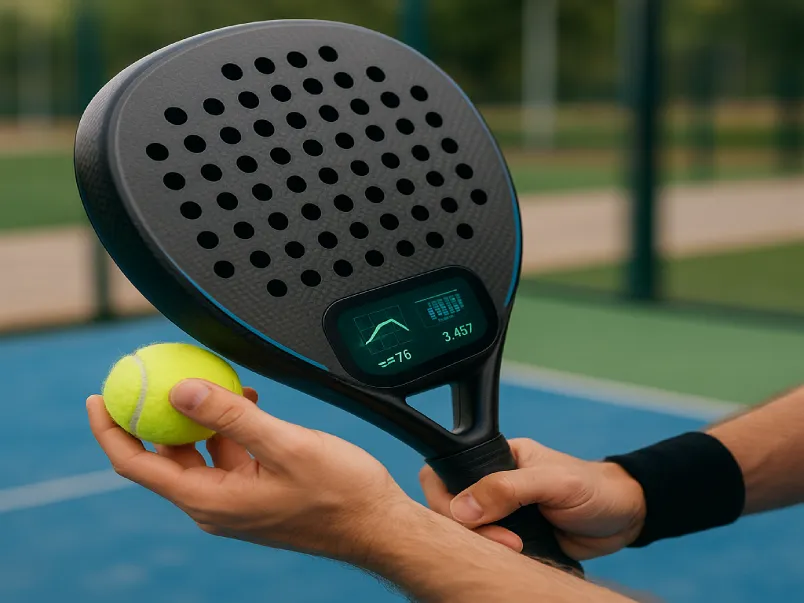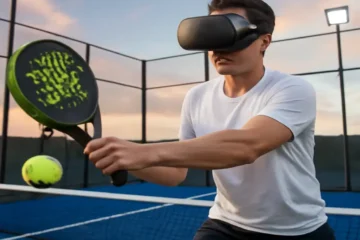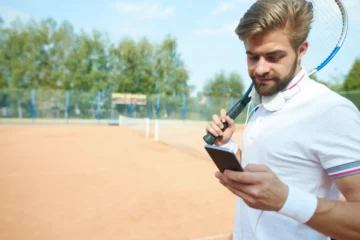I. The Sound of the Future
The familiar sound of a padel ball hitting the racket is a symphony to any player. The thwack of a perfectly executed shot resonates through the court, providing instant feedback to the player. But what if that sound could tell you even more—what if it could reveal everything about your shot’s power, precision, technique, and even potential weaknesses?
This idea is no longer a far-off fantasy. After the rise of smart tennis rackets and wearable fitness trackers, padel, a sport growing rapidly in popularity across the globe, is poised for its own smart revolution. Enter the smart padel racket, a device that combines cutting-edge sensors, artificial intelligence, and data analytics to revolutionize how players train, compete, and understand the game.
Smart paddles are not science fiction—they are an imminent reality that promises to reshape the world of padel. But what exactly does a smart racket do? And how can it change the way players approach their game? Let’s dive into this game-changing technology.
II. What Exactly is a “Smart” Padel Racket?
At its core, a smart padel racket is a traditional racket enhanced with embedded technology designed to track performance. By integrating sensors into the frame, players can collect detailed data on their gameplay. Think of it as combining your racket with a sophisticated coach that provides continuous feedback in real-time.
Key Technological Components of Smart Paddles:
- Inertial Measurement Units (IMUs):
At the heart of every smart racket is the IMU—a small device containing accelerometers and gyroscopes. These sensors measure the racket’s movements, including its orientation, speed, and rotation. When you swing the racket, the IMU tracks the motion, providing detailed data about how your shots are executed. - Vibration Sensors:
Padel players know the feeling of hitting a ball off-center. With the help of vibration sensors, smart paddles can analyze the force and impact location of each shot. These sensors allow players to understand the nuances of their game, such as the sweet spot of their racket, and how different shots feel. - Bluetooth Connectivity:
Data collected by the racket doesn’t just stay on the device. Bluetooth connectivity ensures that the data syncs with a smartphone app, allowing players to access, analyze, and track their performance over time. Some systems even offer real-time feedback during play. - Battery & Charging:
Given the power requirements of these sensors, battery life becomes a critical aspect of smart paddles. Depending on the technology, battery life can vary, but many smart paddles are designed for daily play and charge easily via USB ports or wireless charging systems. - Data Output:
So, what exactly does a smart padel racket measure? Here are some of the key metrics players can track:- Shot Speed & Power: Understand how hard you’re hitting each shot, and track changes in shot velocity over time.
- Shot Type Recognition: A smart racket can identify and categorize different types of shots—whether you’re executing a bandeja, a smash, or a vibora—providing insights into your shot variety.
- Impact Location: Data on where the ball makes contact with the racket, helping players identify off-center hits and improve their technique.
- Swing Path and Wrist Action: The racket can also track the path of your swing and wrist movement, which can be critical in improving your form.
- Play Time & Calories Burned: Some smart paddles even track your exercise intensity, giving you an overview of how much effort you’ve put in and how many calories you’ve burned during a session.
III. The Game-Changing Benefits: Why You Might Want One
Smart paddles offer benefits across different levels of play—from amateur players just starting out to seasoned professionals looking to refine their game. Let’s explore how a smart racket can benefit different groups:
For the Amateur & Recreational Player:
- Objective Feedback: For many recreational players, “feeling” their shot can be subjective. Smart paddles remove the guesswork and provide hard data, allowing players to understand exactly how well they’re performing.
- Progress Tracking: With detailed analytics available at your fingertips, players can monitor their improvement over time, helping them stay motivated and focused on their goals.
- Motivation & Gamification: Many apps that connect with smart paddles offer gamified experiences, allowing players to challenge themselves and track their progress. This turns training into a more fun and engaging experience.
For the Coach & Academy:
- Data-Driven Coaching: Coaches can use the data from smart paddles to identify areas where players need improvement, pinpointing technical flaws with greater accuracy. This ensures that training is more efficient and focused.
- Player Development: Coaches can design personalized training regimens based on individual data, tailoring drills and feedback to the player’s unique needs and playing style.
- Group Session Analysis: Managing a team or multiple players during a training session becomes easier with smart paddles. The data provides a comprehensive view of how each player is performing, allowing for more targeted and effective feedback.
For the Professional & High-Performance Player:
- Match Analysis: For professionals, a smart racket can help with post-match analysis, revealing insights into an opponent’s tendencies and preferred shots, allowing players to strategize more effectively.
- Injury Prevention: By tracking swing mechanics and workload, smart paddles can help identify potentially dangerous techniques, such as excessive overhead smashes, which might lead to injury over time.
- Equipment Optimization: With data on your shot type, speed, and impact location, players can optimize their racket choice, ensuring they select the best one based on their individual performance data—not just marketing.
IV. The Inevitable Challenges and Hurdles
While the potential benefits of smart paddles are clear, there are several challenges that need to be addressed:
- The Weight and Balance Dilemma: One of the primary concerns is how technology might affect the feel of the racket. The extra weight and altered balance from embedded sensors could impact the racket’s maneuverability, which is crucial in a fast-paced sport like padel.
- Durability Concerns: Padel is a physically demanding sport. The racket faces considerable shock and vibration with each hit, raising questions about the durability of the electronics inside. Will smart paddles hold up under the intense conditions of a professional match?
- The Cost Factor: As with any new technology, smart paddles come with a premium price tag. While the technology will likely become more affordable over time, the current cost of these devices may put them out of reach for many recreational players.
- Data Overload: Too much data can be overwhelming, especially if it isn’t properly interpreted. For many players, especially amateurs, sifting through complex metrics without the proper context or coaching guidance might lead to confusion or frustration.
- Regulation & Fair Play: One significant hurdle for smart paddles is the question of whether they will be allowed in official competitions. Could the use of smart paddles create an unfair advantage? Will the governing bodies of padel allow players to use them in tournaments?
V. Who’s Leading the Charge? A Look at the Pioneers
Several companies and brands are already working on integrating technology into padel rackets, with both established names and innovative startups jumping into the fray.
1. Babolat (Padel-Pulse):
Babolat, already a major player in tennis with its POP technology, is poised to bring its expertise to the padel world. Their Padel-Pulse racket promises to offer smart features that will track performance metrics, similar to the company’s tennis racket offerings.
2. Spintrack:
Spintrack has already released a smart padel racket, providing players with real-time feedback on their shots, such as speed and shot type. This early entry into the market has set the standard for what players can expect from smart paddles.
3. Other Startups:
Several startups and crowdfunding projects are exploring prototypes for smart padel rackets. While many are still in development, the promise of innovative designs and affordable solutions is driving the industry forward.
4. Aftermarket Solutions:
For players who already own a racket but want to experience the benefits of smart technology, there are sensor attachments available. Products like SwingVision or Blast Motion offer aftermarket solutions that can be attached to any racket, allowing players to monitor their performance without purchasing a whole new device.
VI. The Future of Smart Padel: Beyond the Racket
While smart paddles are the star of the show, the future of padel technology extends beyond just the racket. Let’s look at some exciting developments on the horizon:
1. Smart Courts:
The integration of smart courts could take the sport to the next level. By combining data from smart paddles with cameras placed around the court, players can get a 360-degree view of their performance. Instant replays, detailed analytics, and even suggestions for improving shot placement could all be powered by this technology.
2. Wearable Synergy:
Imagine combining data from your smart racket with information from wearable devices like smartwatches that track heart rate or muscle activity. This would provide a complete picture of your performance, from technique to physical exertion, helping you train smarter and reduce the risk of injury.
3. The Rise of AI Coaches:
AI-powered virtual coaches could soon become a reality. By analyzing the data from your smart racket, AI coaches would offer real-time tips and drills to improve your gameplay, essentially acting as a personalized coach at your fingertips.
4. Enhanced Fan Experience:
For fans watching professional matches, smart paddles could offer real-time data visualizations. Stats like shot speed, power, and player fatigue could be displayed on screens, giving fans deeper insights into the game.
VII. Conclusion: To Smart or Not to Smart?
Smart padel rackets are on the verge of transforming the game. With their potential to enhance training, improve technique, and offer data-driven insights, these devices will surely become integral to the future of padel. Whether for an amateur player looking to improve or a pro aiming for perfection, the advantages are clear.
While the core of padel will always rely on skill, strategy, and enjoyment, smart technology offers a powerful new lens through which to view the sport. The question is no longer if smart paddles will become mainstream, but when—and how quickly they will change the way we play.
❓ FAQs
1. What are smart paddles in padel?
Smart paddles are technologically enhanced rackets equipped with built-in sensors that track performance data such as speed, impact location, and swing accuracy, helping players analyze and improve their game.
2. How do smart paddles work?
They use motion sensors and Bluetooth connectivity to collect and transmit real-time data to a connected app, offering insights into a player’s technique and performance trends.
3. Are smart paddles legal in professional padel tournaments?
Most professional tournaments currently allow standard paddles only, but as technology evolves, governing bodies are considering how smart paddles might fit into future competitions.
4. What are the benefits of using a smart paddle?
Players can receive instant feedback, track progress over time, identify weaknesses, and optimize training sessions with precise, data-driven metrics.
5. Do smart paddles require charging?
Yes. Most smart paddles come with rechargeable batteries that typically last several matches before needing a charge.
6. Are smart paddles suitable for beginners?
Absolutely. While advanced players use them for performance optimization, beginners benefit from the guided feedback and improvement tips provided by the companion apps.
7. How much do smart paddles cost compared to regular ones?
Smart paddles are generally more expensive due to their built-in technology, with prices ranging from 1.5x to 3x the cost of a standard high-quality paddle.
8. What brands are leading the smart paddle revolution?
Several innovative brands like Babolat, Playtomic, and Head are exploring or launching smart paddle models that blend performance with cutting-edge tech.




